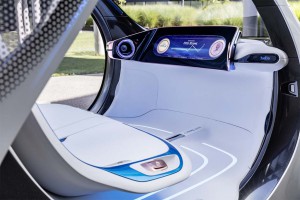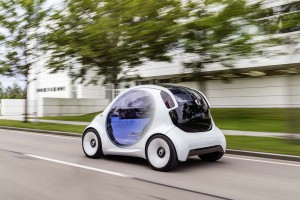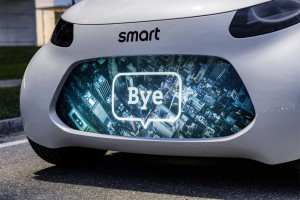Earlier this year, Daimler’s Smart city car brand announced it would go all-electric in the U.S. market, abandoning the gas-powered remake of the two-seat Fortwo model it had launched here barely a year before.
Few would be surprised to see Smart abandon the internal combustion engine entirely in the not-too-distant future. But that might be just one of the many changes Daimler appears to be envisioning for the city car brand. The new Smart Vision EQ Fortwo Concept due to debut at the Frankfurt Motor Show next month gives us a hint of what else might be in store.
“The Smart Vision EQ Fortwo is our vision of future urban mobility; it is the most radical car sharing concept car of all: fully autonomous, with maximum communication capabilities, friendly, comprehensively personalisable and, of course, electric,” said Smart CEO Annette Winkler.
“With the smart vision EQ fortwo, we are giving a face to the themes with which Mercedes-Benz Cars describes the vision of future mobility within the CASE strategy.”
“CASE” is Daimler’s shorthand for:
- Connected vehicles, ones with the capability of plugging into a roadway infrastructure while also communicating with other cars on the road;
- Autonomous and driverless vehicles which are expected to become increasingly commonplace in the decades ahead;
- Shared vehicles, those operating either as part of a ride-sharing service like Uber or Lyft, or a car-sharing service such as Car2Go; and
- Electrified vehicles, which can cover a spectrum from hybrids to plug-ins to pure battery-electric models.
A quick look at the Smart Vision EQ Fortwo concept says it checks all four of those boxes.
(Smart going all-electric in U.S. market. For the story, Click Here.)
Visually, you’ll likely recognize the show car as a Smart Fortwo, though it gets a bit more modern, and rounded appearance. The most distinctive visual element, however, are the butterfly doors which pivot up and back over the rear wheels.
Inside, the Fortwo concept is almost Scandinavian in its sparseness, with a bench-like front seat, a touchscreen that runs nearly door to door, and subtle two-tone white-and-blue materials. Smart has engineered in a few nifty details, including storage below the seats, as well as below the Vision’s A-pillars.

The interior of the Smart Vision EQ Fortwo is sparse, yet modern highlighting the advanced technology in the vehicle.
Here, however, the most notable detail is what the interior doesn’t feature. There is no steering wheel and no pedals. The Vision EQ Fortwo is meant to operate as a driverless vehicle.
As part of either a ride- or car-sharing service, one would tap a smartphone app to have the vehicle come and pick you up.
What you won’t immediately notice is that the prototype is designed to use V2X technologies, a vehicle-to-vehicle system to digitally chat with other cars, vehicle-to-infrastructure to plug into a roadside network. That would allow the driverless control system to adapt to traffic, weather and other conditions, even be alerted if another vehicle were to inadvertently run a red light.
One of the more novel communications systems would also allow the Vision EQ Fortwo to communicate with pedestrians and human drivers by flashing messages on screens mounted to the outside of the vehicle. That’s something that could prove particularly useful in the future as, without a driver behind a steering wheel, a pedestrian wouldn’t be able to tell if a vehicle were going to wait for them to cross the street, for example.
(Click Here for more about the Fortwo electric.)
And, of course, there’s a pure battery-electric drivetrain hidden underneath. By designing the EQ specifically to run on battery power the positioning of batteries and other hardware can be optimized. The pack, for example, is mounted under the load floor, freeing up extra room so the Vision EQ offers more room for passengers and cargo than today’s Fortwo without stretching the microcar’s platform. The concept measures a grand total of just 8.8 feet, nose-to-tail.
The current Smart Fortwo ED uses a 17.6 kilowatt-hour lithium-ion battery that can manage 99 miles in coupe form, 96 for the cabriolet. The automaker isn’t saying what the concept could manage but as it would likely use lighter weight materials and features better aerodynamics, we’d expect something closer to the mid-100 mile range per charge. And, if some of the new battery technology now being talked about – notably lithium solid-state — were to prove viable, that figure could increase substantially.
The current ED model needs 2.5 hours on a Level II charger to maximize range. The Vision EQ could plug in or use a wireless inductive system. By the time it were to reach market, meanwhile, high-speed Level III and IV charging systems would likely be widely available, bringing charge times down to less than 30 minutes and perhaps as little as 5 minutes.
The use of the “EQ,” rather than “ED,” in the name of the Vision concept is no misspelling. It reflects the fact that parent Daimler plans to have at least 10 fully electrified models in its Mercedes-Benz and Smart line-up by 2022. We expect to see a production version of the Mercedes-EQ concept that debuted at last year’s Paris Motor Show land in showrooms by late this decade.
(Smart “all-in” on battery cars. Click Here for the story.)
We wouldn’t be surprised to see a number of features from the Smart Vision EQ Fortwo concept work their way into production soon afterwards, though it would likely take until late in the coming decade before there would be a fully driverless version roaming urban roads.



